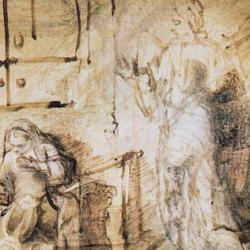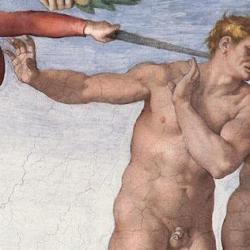Thomas Brodie (Genesis As Dialogue) argues that “Genesis consists of twenty-six diptychs. Building on older insights that several Genesis texts occur in pairs and that Genesis is somehow binary or dialogical, this study makes a basic observation: The entire book is composed of diptychs—accounts which, like some paintings, consist of two parts or panels.”
He gives several examples: “There are . . . two panels of creation (1:1–2:24), two of primordial sin (2:25–4:16), two genealogies (4:17–chap. 5), two parts to the flood story (6:1–9:1:17), two complementary histories about Noah’s sons (9: 18–chap. 10), and so on—to a total of twenty-six diptychs (six in chaps. 1–11, seven in the Abraham story, six in the initial Jacob story, and seven in the Joseph story). Genesis then falls into fifty-two panels—a refinement of the medieval division into fifty chapters” (xi-xii).
Twenty-six, you say? As in the gematria of YHWH?
After the double creation account, Brodie finds a double account of the fall – the forbidden fruit in the garden (2:25-3) and Cain’s murder of Abel (4:1-16). The two accounts are linked in multiple ways. They tell similar stories, but along a different axis:
“Rather as the creation diptych (Gen. 1: 1–2:24) was representative of the two basic types of creation narratives, so the crime-and-punishment diptych also is broadly representative. The first crime is primarily vertical, against God; the second is more horizontal, against another human being. Furthermore, these two crimes involve two of the most basic pairings in life: man-woman; and brother-brother. By portraying two basic couples and two basic kinds of crime or sin, the diptych as a whole is typical or representative” (143).
Here is a modified version of Brodie’s chart of the parallels between the episodes (144):
| The setting | |
| They. . .the man and his wife. . . | The man knew. . .his wife |
| The serpent. . .of the field. . . | Sin crouching. . . into the field. |
| Fruit forbidden by God. | Fruit not regarded by God. |
| Problem: relation to God. | Problem: relation, through God, to Abel. |
| The drama on the face: the eyes’ delight, desire. | The drama on the face: distress, face fallen. |
| Crime and punishment | |
| After eating: they knew. . . | After killing: Where is Abel. . . ? |
| They heard the voice. . . | The voice. . .is crying to me |
| I hid. | I must hide/be concealed. |
| Avoiding responsibility: : It was the woman. . .the serpent. | Avoiding responsibility Am I my brother’s keeper? |
| Because you have done this, cursed are you. . . cursed is the ground because of you. | What have you done? Now you are cursed from the ground. |
| The aftermath | |
| God’s protective action: Clothes them. | God’s protective action: Puts a sign on Cain. |
| God cast them out of Eden. | Cain went out from God. |
| Cherubim placed east of. . . Eden. | Cain dwelt east of Eden. |
Beyond this, the double fall is echoed again later on in the post-diluvian account of Noah’s sons: “The two sin accounts (2:25–4:16, including Cain) are mirrored obscurely in the stories of Noah’s sons (including Canaan, 9:18–chap. 10). In particular, the drama of the tree, nakedness, and the eyes (2:24–chap. 3), is partly reversed in the drama involving another strange tree (the vine) and the turning away of the eyes from nakedness (9:18–29)” (17).











